Analysis of Air Quality Monitoring and Control in the Cement Industry
VerifiedAdded on 2020/04/01
|11
|2491
|52
Report
AI Summary
This report provides a comprehensive overview of air quality monitoring and control strategies within the cement industry. It begins by highlighting the significant environmental impacts of cement production, including substantial carbon emissions and the release of particulate matter, carbon monoxide, sulfur dioxide, and other pollutants. The report then reviews various air quality control devices, such as electrostatic precipitators (ESPs), baghouses, wet scrubbers, cyclone separators, and gravity settlers, detailing their operational mechanisms, advantages, and limitations. The discussion covers the importance of these technologies in mitigating environmental impacts, considering increasing cement demand and production. The report emphasizes the need for continuous monitoring and control to comply with environmental regulations and reduce pollution from cement production facilities. The report also includes an introduction and literature review, along with references.
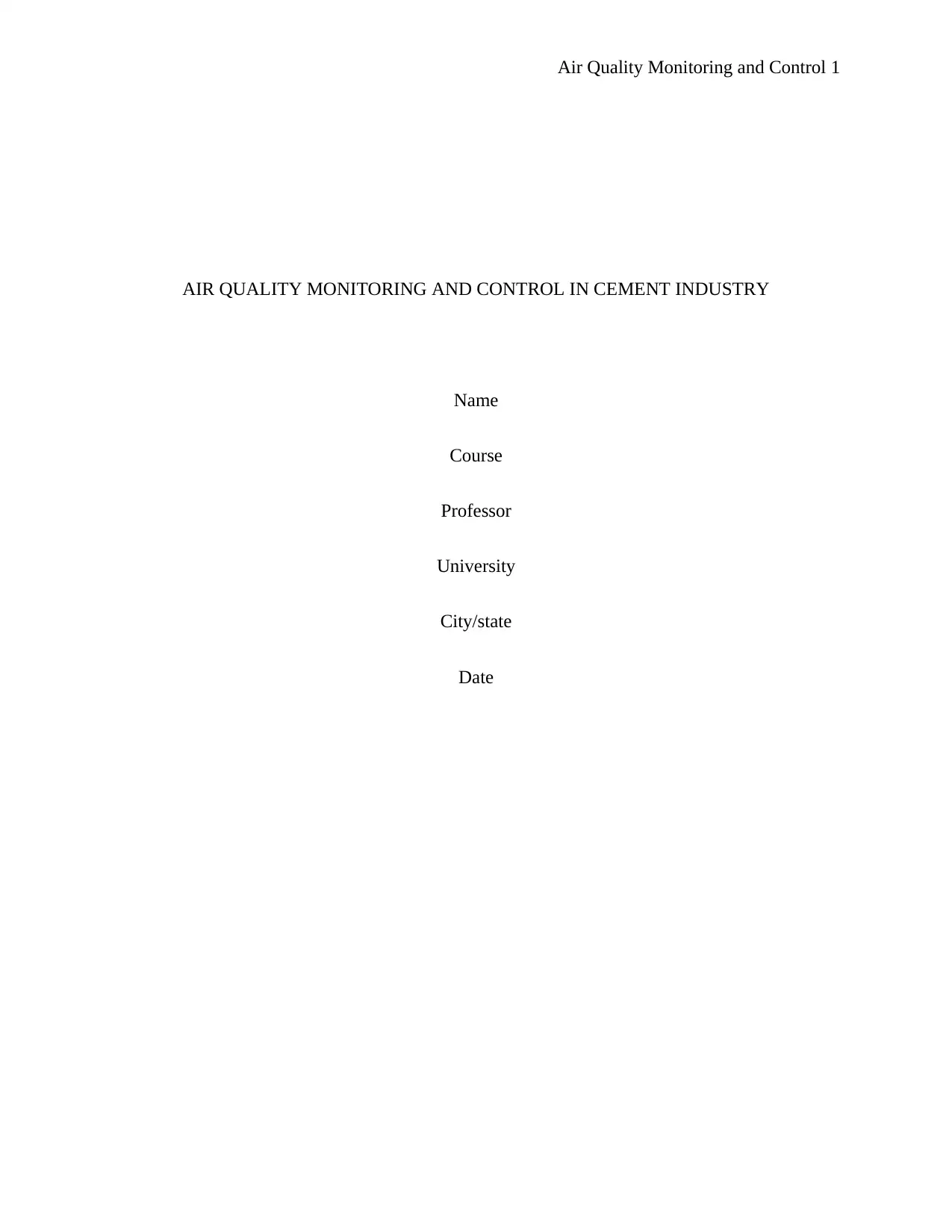
Air Quality Monitoring and Control 1
AIR QUALITY MONITORING AND CONTROL IN CEMENT INDUSTRY
Name
Course
Professor
University
City/state
Date
AIR QUALITY MONITORING AND CONTROL IN CEMENT INDUSTRY
Name
Course
Professor
University
City/state
Date
Paraphrase This Document
Need a fresh take? Get an instant paraphrase of this document with our AI Paraphraser
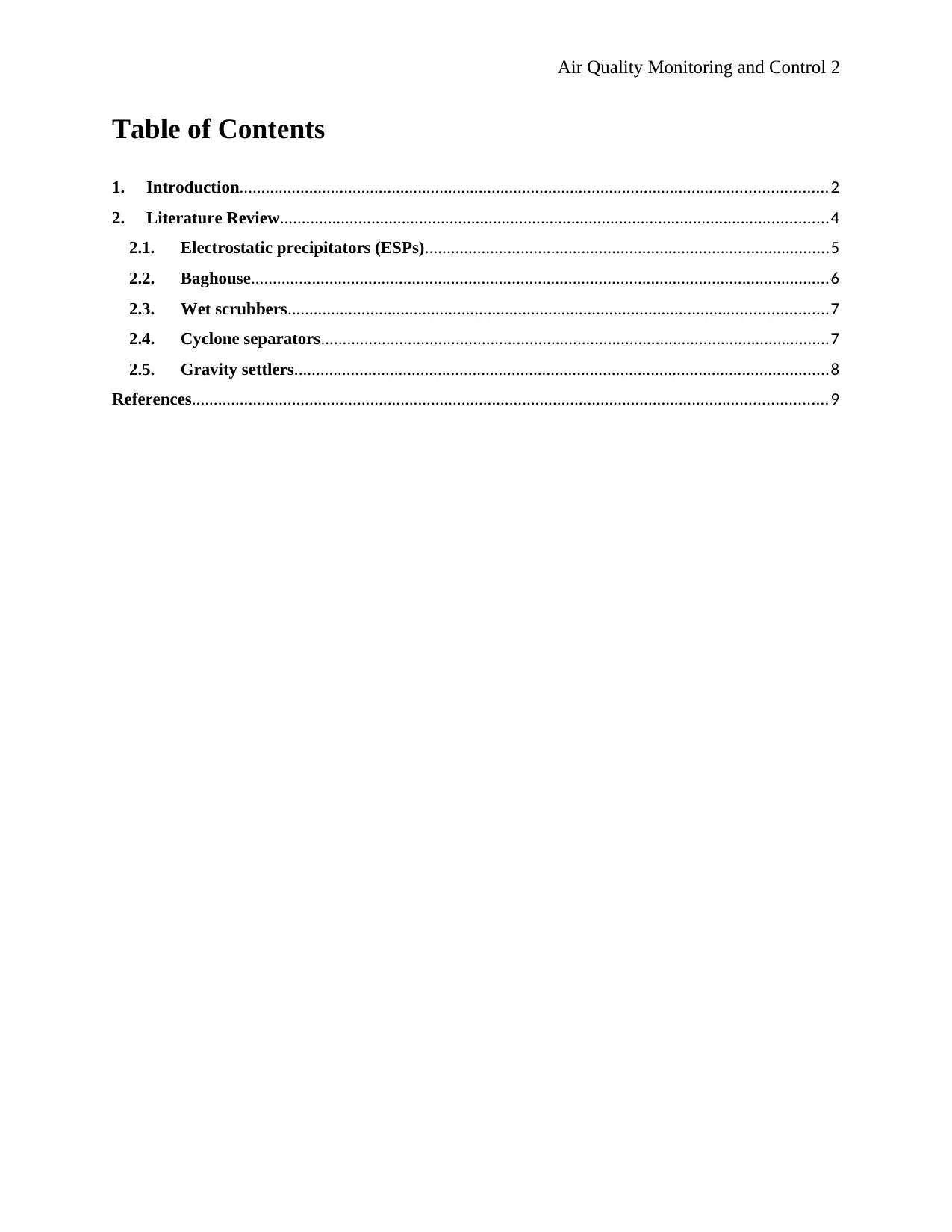
Air Quality Monitoring and Control 2
Table of Contents
1. Introduction.......................................................................................................................................2
2. Literature Review..............................................................................................................................4
2.1. Electrostatic precipitators (ESPs).............................................................................................5
2.2. Baghouse.....................................................................................................................................6
2.3. Wet scrubbers............................................................................................................................7
2.4. Cyclone separators.....................................................................................................................7
2.5. Gravity settlers...........................................................................................................................8
References..................................................................................................................................................9
Table of Contents
1. Introduction.......................................................................................................................................2
2. Literature Review..............................................................................................................................4
2.1. Electrostatic precipitators (ESPs).............................................................................................5
2.2. Baghouse.....................................................................................................................................6
2.3. Wet scrubbers............................................................................................................................7
2.4. Cyclone separators.....................................................................................................................7
2.5. Gravity settlers...........................................................................................................................8
References..................................................................................................................................................9
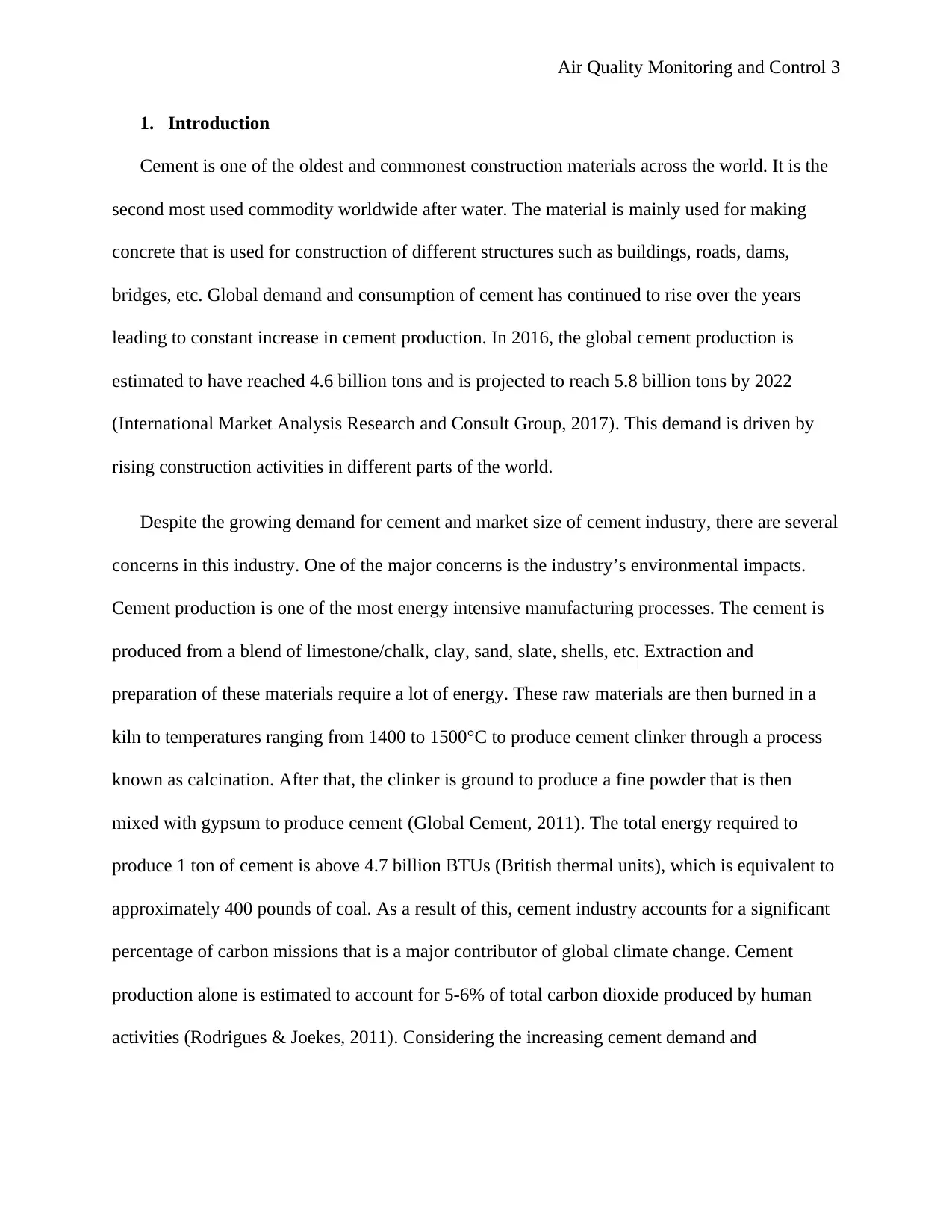
Air Quality Monitoring and Control 3
1. Introduction
Cement is one of the oldest and commonest construction materials across the world. It is the
second most used commodity worldwide after water. The material is mainly used for making
concrete that is used for construction of different structures such as buildings, roads, dams,
bridges, etc. Global demand and consumption of cement has continued to rise over the years
leading to constant increase in cement production. In 2016, the global cement production is
estimated to have reached 4.6 billion tons and is projected to reach 5.8 billion tons by 2022
(International Market Analysis Research and Consult Group, 2017). This demand is driven by
rising construction activities in different parts of the world.
Despite the growing demand for cement and market size of cement industry, there are several
concerns in this industry. One of the major concerns is the industry’s environmental impacts.
Cement production is one of the most energy intensive manufacturing processes. The cement is
produced from a blend of limestone/chalk, clay, sand, slate, shells, etc. Extraction and
preparation of these materials require a lot of energy. These raw materials are then burned in a
kiln to temperatures ranging from 1400 to 1500°C to produce cement clinker through a process
known as calcination. After that, the clinker is ground to produce a fine powder that is then
mixed with gypsum to produce cement (Global Cement, 2011). The total energy required to
produce 1 ton of cement is above 4.7 billion BTUs (British thermal units), which is equivalent to
approximately 400 pounds of coal. As a result of this, cement industry accounts for a significant
percentage of carbon missions that is a major contributor of global climate change. Cement
production alone is estimated to account for 5-6% of total carbon dioxide produced by human
activities (Rodrigues & Joekes, 2011). Considering the increasing cement demand and
1. Introduction
Cement is one of the oldest and commonest construction materials across the world. It is the
second most used commodity worldwide after water. The material is mainly used for making
concrete that is used for construction of different structures such as buildings, roads, dams,
bridges, etc. Global demand and consumption of cement has continued to rise over the years
leading to constant increase in cement production. In 2016, the global cement production is
estimated to have reached 4.6 billion tons and is projected to reach 5.8 billion tons by 2022
(International Market Analysis Research and Consult Group, 2017). This demand is driven by
rising construction activities in different parts of the world.
Despite the growing demand for cement and market size of cement industry, there are several
concerns in this industry. One of the major concerns is the industry’s environmental impacts.
Cement production is one of the most energy intensive manufacturing processes. The cement is
produced from a blend of limestone/chalk, clay, sand, slate, shells, etc. Extraction and
preparation of these materials require a lot of energy. These raw materials are then burned in a
kiln to temperatures ranging from 1400 to 1500°C to produce cement clinker through a process
known as calcination. After that, the clinker is ground to produce a fine powder that is then
mixed with gypsum to produce cement (Global Cement, 2011). The total energy required to
produce 1 ton of cement is above 4.7 billion BTUs (British thermal units), which is equivalent to
approximately 400 pounds of coal. As a result of this, cement industry accounts for a significant
percentage of carbon missions that is a major contributor of global climate change. Cement
production alone is estimated to account for 5-6% of total carbon dioxide produced by human
activities (Rodrigues & Joekes, 2011). Considering the increasing cement demand and
⊘ This is a preview!⊘
Do you want full access?
Subscribe today to unlock all pages.

Trusted by 1+ million students worldwide
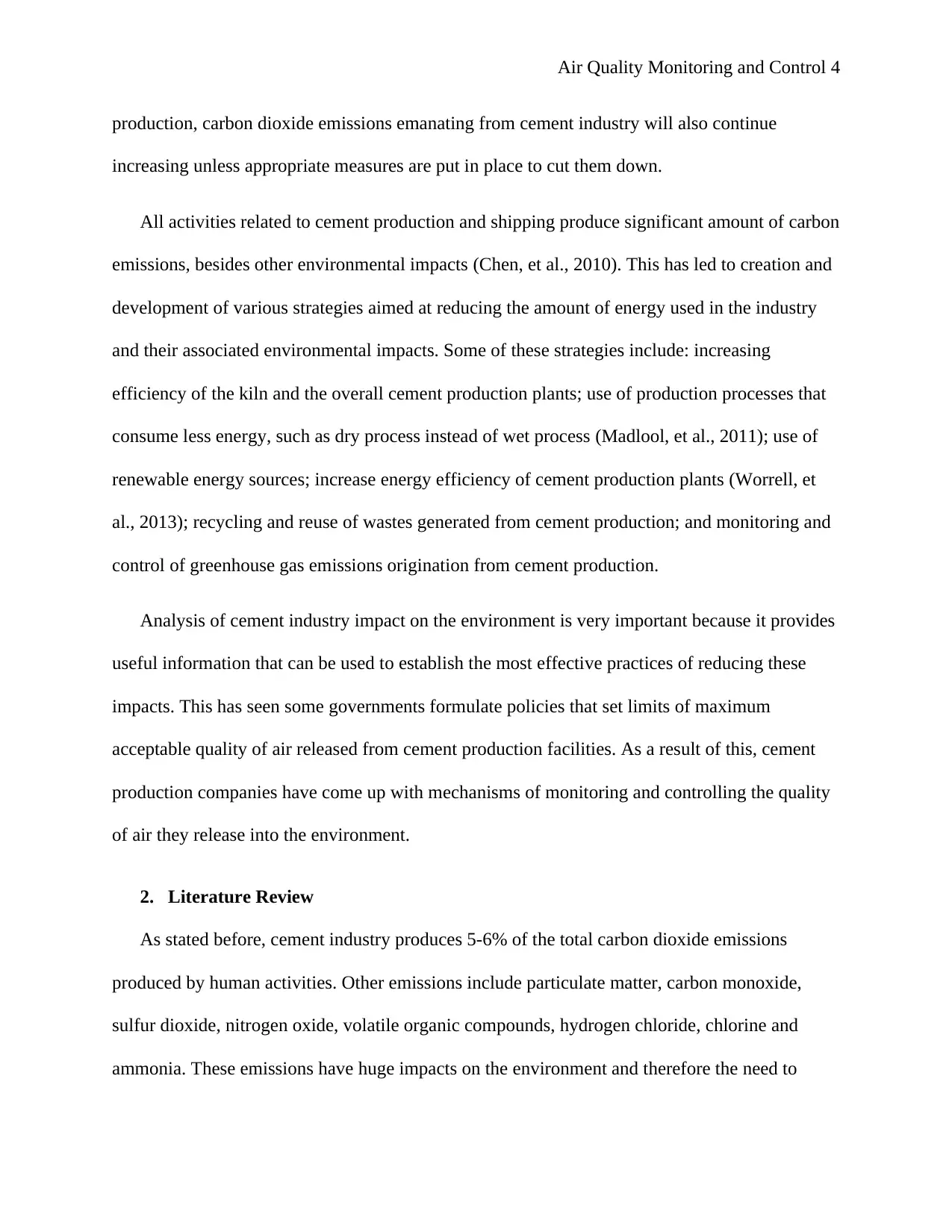
Air Quality Monitoring and Control 4
production, carbon dioxide emissions emanating from cement industry will also continue
increasing unless appropriate measures are put in place to cut them down.
All activities related to cement production and shipping produce significant amount of carbon
emissions, besides other environmental impacts (Chen, et al., 2010). This has led to creation and
development of various strategies aimed at reducing the amount of energy used in the industry
and their associated environmental impacts. Some of these strategies include: increasing
efficiency of the kiln and the overall cement production plants; use of production processes that
consume less energy, such as dry process instead of wet process (Madlool, et al., 2011); use of
renewable energy sources; increase energy efficiency of cement production plants (Worrell, et
al., 2013); recycling and reuse of wastes generated from cement production; and monitoring and
control of greenhouse gas emissions origination from cement production.
Analysis of cement industry impact on the environment is very important because it provides
useful information that can be used to establish the most effective practices of reducing these
impacts. This has seen some governments formulate policies that set limits of maximum
acceptable quality of air released from cement production facilities. As a result of this, cement
production companies have come up with mechanisms of monitoring and controlling the quality
of air they release into the environment.
2. Literature Review
As stated before, cement industry produces 5-6% of the total carbon dioxide emissions
produced by human activities. Other emissions include particulate matter, carbon monoxide,
sulfur dioxide, nitrogen oxide, volatile organic compounds, hydrogen chloride, chlorine and
ammonia. These emissions have huge impacts on the environment and therefore the need to
production, carbon dioxide emissions emanating from cement industry will also continue
increasing unless appropriate measures are put in place to cut them down.
All activities related to cement production and shipping produce significant amount of carbon
emissions, besides other environmental impacts (Chen, et al., 2010). This has led to creation and
development of various strategies aimed at reducing the amount of energy used in the industry
and their associated environmental impacts. Some of these strategies include: increasing
efficiency of the kiln and the overall cement production plants; use of production processes that
consume less energy, such as dry process instead of wet process (Madlool, et al., 2011); use of
renewable energy sources; increase energy efficiency of cement production plants (Worrell, et
al., 2013); recycling and reuse of wastes generated from cement production; and monitoring and
control of greenhouse gas emissions origination from cement production.
Analysis of cement industry impact on the environment is very important because it provides
useful information that can be used to establish the most effective practices of reducing these
impacts. This has seen some governments formulate policies that set limits of maximum
acceptable quality of air released from cement production facilities. As a result of this, cement
production companies have come up with mechanisms of monitoring and controlling the quality
of air they release into the environment.
2. Literature Review
As stated before, cement industry produces 5-6% of the total carbon dioxide emissions
produced by human activities. Other emissions include particulate matter, carbon monoxide,
sulfur dioxide, nitrogen oxide, volatile organic compounds, hydrogen chloride, chlorine and
ammonia. These emissions have huge impacts on the environment and therefore the need to
Paraphrase This Document
Need a fresh take? Get an instant paraphrase of this document with our AI Paraphraser
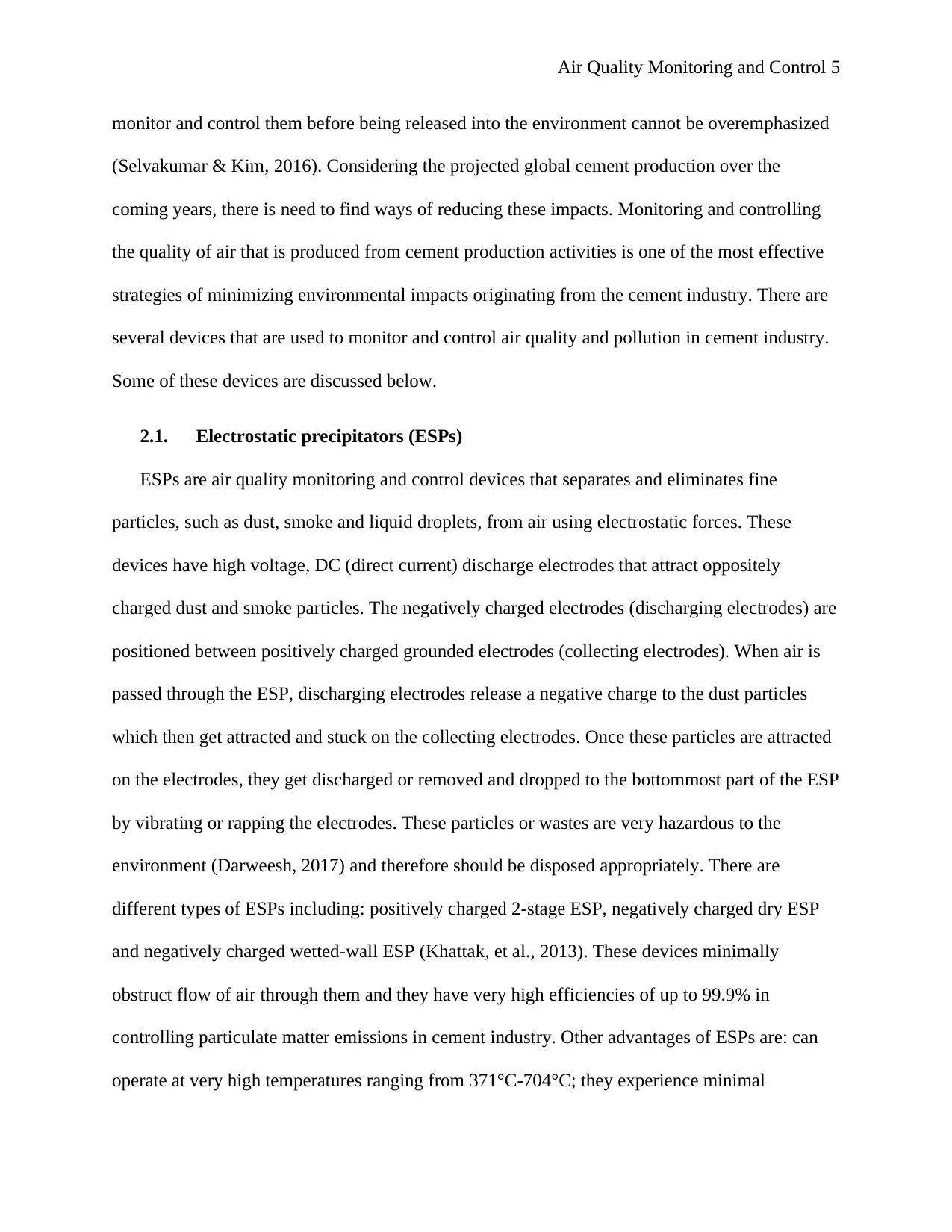
Air Quality Monitoring and Control 5
monitor and control them before being released into the environment cannot be overemphasized
(Selvakumar & Kim, 2016). Considering the projected global cement production over the
coming years, there is need to find ways of reducing these impacts. Monitoring and controlling
the quality of air that is produced from cement production activities is one of the most effective
strategies of minimizing environmental impacts originating from the cement industry. There are
several devices that are used to monitor and control air quality and pollution in cement industry.
Some of these devices are discussed below.
2.1. Electrostatic precipitators (ESPs)
ESPs are air quality monitoring and control devices that separates and eliminates fine
particles, such as dust, smoke and liquid droplets, from air using electrostatic forces. These
devices have high voltage, DC (direct current) discharge electrodes that attract oppositely
charged dust and smoke particles. The negatively charged electrodes (discharging electrodes) are
positioned between positively charged grounded electrodes (collecting electrodes). When air is
passed through the ESP, discharging electrodes release a negative charge to the dust particles
which then get attracted and stuck on the collecting electrodes. Once these particles are attracted
on the electrodes, they get discharged or removed and dropped to the bottommost part of the ESP
by vibrating or rapping the electrodes. These particles or wastes are very hazardous to the
environment (Darweesh, 2017) and therefore should be disposed appropriately. There are
different types of ESPs including: positively charged 2-stage ESP, negatively charged dry ESP
and negatively charged wetted-wall ESP (Khattak, et al., 2013). These devices minimally
obstruct flow of air through them and they have very high efficiencies of up to 99.9% in
controlling particulate matter emissions in cement industry. Other advantages of ESPs are: can
operate at very high temperatures ranging from 371°C-704°C; they experience minimal
monitor and control them before being released into the environment cannot be overemphasized
(Selvakumar & Kim, 2016). Considering the projected global cement production over the
coming years, there is need to find ways of reducing these impacts. Monitoring and controlling
the quality of air that is produced from cement production activities is one of the most effective
strategies of minimizing environmental impacts originating from the cement industry. There are
several devices that are used to monitor and control air quality and pollution in cement industry.
Some of these devices are discussed below.
2.1. Electrostatic precipitators (ESPs)
ESPs are air quality monitoring and control devices that separates and eliminates fine
particles, such as dust, smoke and liquid droplets, from air using electrostatic forces. These
devices have high voltage, DC (direct current) discharge electrodes that attract oppositely
charged dust and smoke particles. The negatively charged electrodes (discharging electrodes) are
positioned between positively charged grounded electrodes (collecting electrodes). When air is
passed through the ESP, discharging electrodes release a negative charge to the dust particles
which then get attracted and stuck on the collecting electrodes. Once these particles are attracted
on the electrodes, they get discharged or removed and dropped to the bottommost part of the ESP
by vibrating or rapping the electrodes. These particles or wastes are very hazardous to the
environment (Darweesh, 2017) and therefore should be disposed appropriately. There are
different types of ESPs including: positively charged 2-stage ESP, negatively charged dry ESP
and negatively charged wetted-wall ESP (Khattak, et al., 2013). These devices minimally
obstruct flow of air through them and they have very high efficiencies of up to 99.9% in
controlling particulate matter emissions in cement industry. Other advantages of ESPs are: can
operate at very high temperatures ranging from 371°C-704°C; they experience minimal
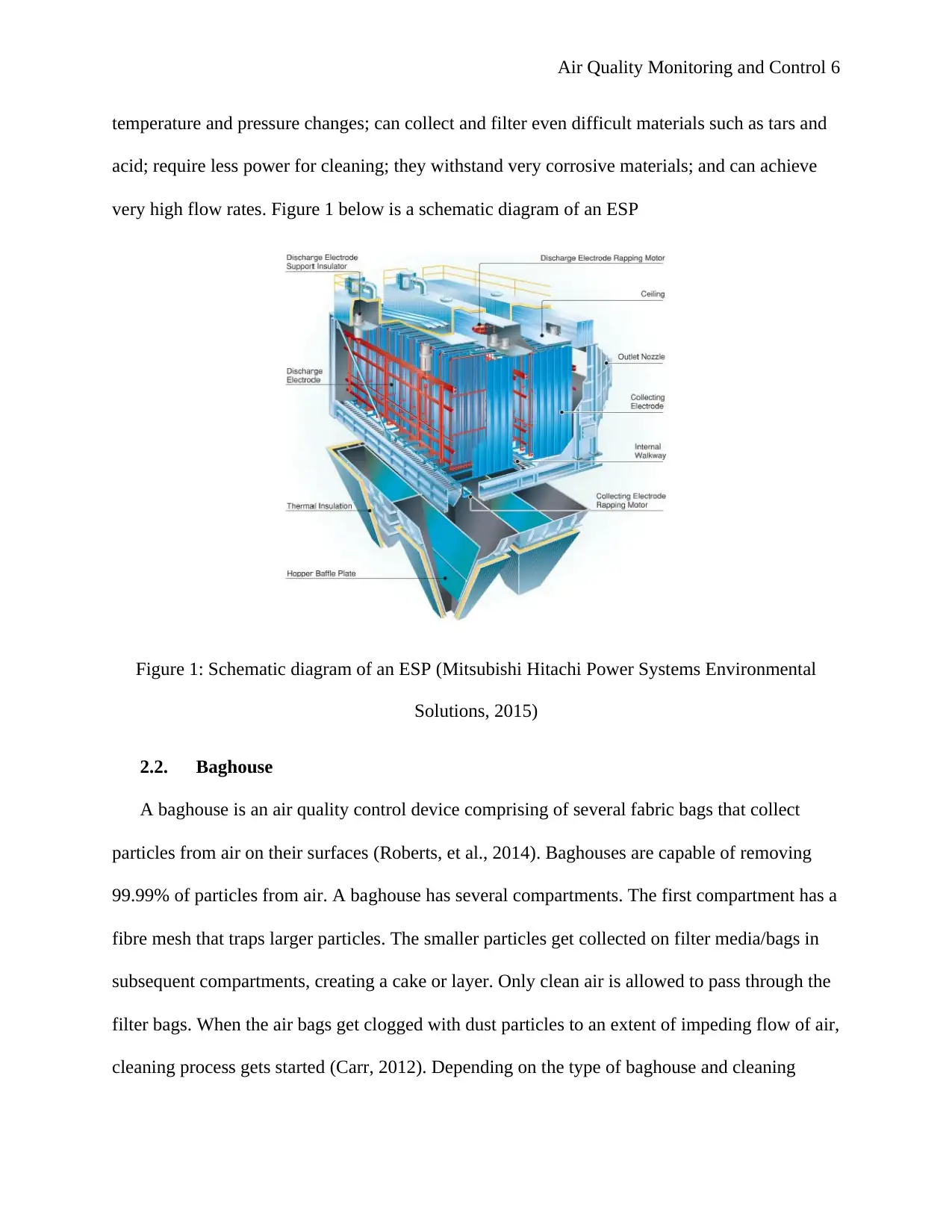
Air Quality Monitoring and Control 6
temperature and pressure changes; can collect and filter even difficult materials such as tars and
acid; require less power for cleaning; they withstand very corrosive materials; and can achieve
very high flow rates. Figure 1 below is a schematic diagram of an ESP
Figure 1: Schematic diagram of an ESP (Mitsubishi Hitachi Power Systems Environmental
Solutions, 2015)
2.2. Baghouse
A baghouse is an air quality control device comprising of several fabric bags that collect
particles from air on their surfaces (Roberts, et al., 2014). Baghouses are capable of removing
99.99% of particles from air. A baghouse has several compartments. The first compartment has a
fibre mesh that traps larger particles. The smaller particles get collected on filter media/bags in
subsequent compartments, creating a cake or layer. Only clean air is allowed to pass through the
filter bags. When the air bags get clogged with dust particles to an extent of impeding flow of air,
cleaning process gets started (Carr, 2012). Depending on the type of baghouse and cleaning
temperature and pressure changes; can collect and filter even difficult materials such as tars and
acid; require less power for cleaning; they withstand very corrosive materials; and can achieve
very high flow rates. Figure 1 below is a schematic diagram of an ESP
Figure 1: Schematic diagram of an ESP (Mitsubishi Hitachi Power Systems Environmental
Solutions, 2015)
2.2. Baghouse
A baghouse is an air quality control device comprising of several fabric bags that collect
particles from air on their surfaces (Roberts, et al., 2014). Baghouses are capable of removing
99.99% of particles from air. A baghouse has several compartments. The first compartment has a
fibre mesh that traps larger particles. The smaller particles get collected on filter media/bags in
subsequent compartments, creating a cake or layer. Only clean air is allowed to pass through the
filter bags. When the air bags get clogged with dust particles to an extent of impeding flow of air,
cleaning process gets started (Carr, 2012). Depending on the type of baghouse and cleaning
⊘ This is a preview!⊘
Do you want full access?
Subscribe today to unlock all pages.

Trusted by 1+ million students worldwide
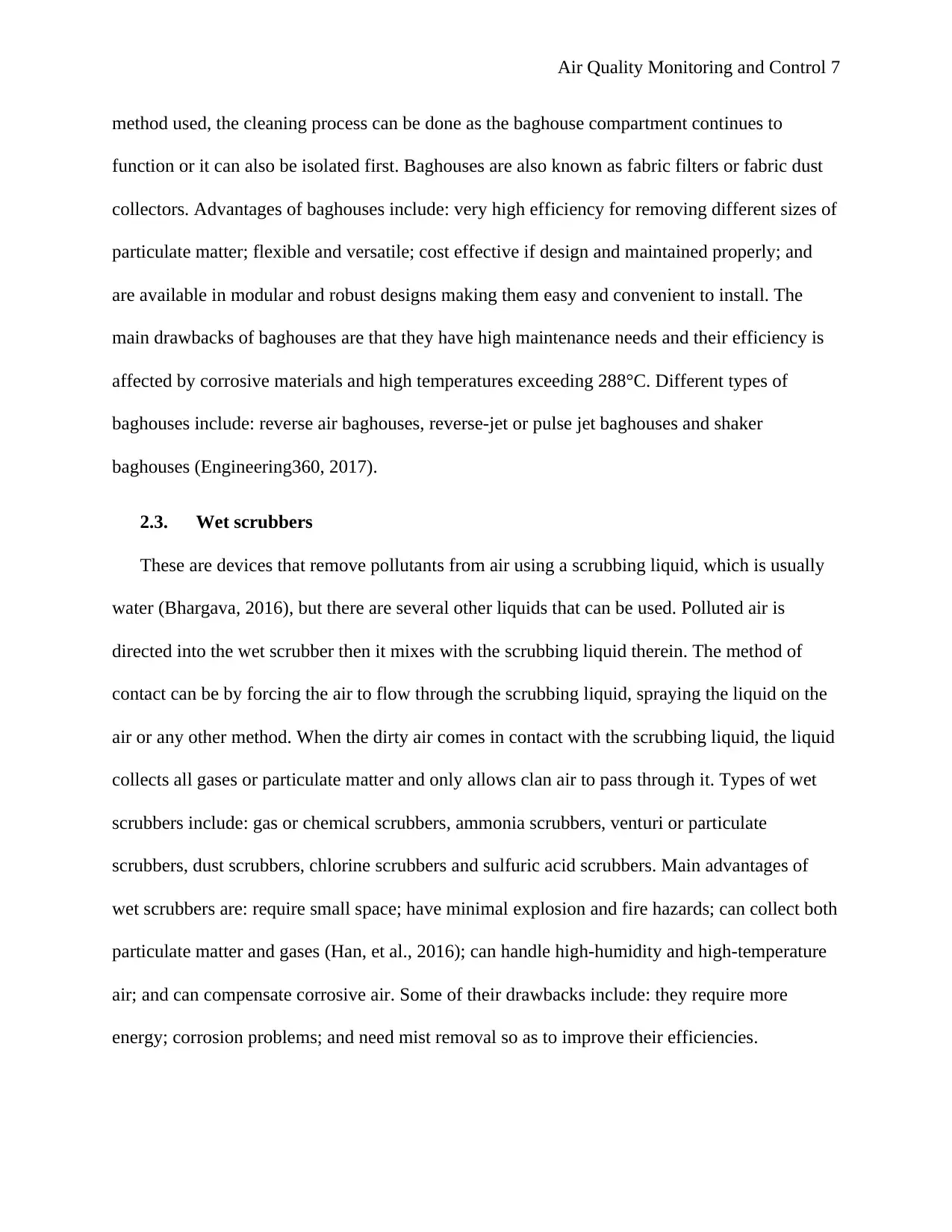
Air Quality Monitoring and Control 7
method used, the cleaning process can be done as the baghouse compartment continues to
function or it can also be isolated first. Baghouses are also known as fabric filters or fabric dust
collectors. Advantages of baghouses include: very high efficiency for removing different sizes of
particulate matter; flexible and versatile; cost effective if design and maintained properly; and
are available in modular and robust designs making them easy and convenient to install. The
main drawbacks of baghouses are that they have high maintenance needs and their efficiency is
affected by corrosive materials and high temperatures exceeding 288°C. Different types of
baghouses include: reverse air baghouses, reverse-jet or pulse jet baghouses and shaker
baghouses (Engineering360, 2017).
2.3. Wet scrubbers
These are devices that remove pollutants from air using a scrubbing liquid, which is usually
water (Bhargava, 2016), but there are several other liquids that can be used. Polluted air is
directed into the wet scrubber then it mixes with the scrubbing liquid therein. The method of
contact can be by forcing the air to flow through the scrubbing liquid, spraying the liquid on the
air or any other method. When the dirty air comes in contact with the scrubbing liquid, the liquid
collects all gases or particulate matter and only allows clan air to pass through it. Types of wet
scrubbers include: gas or chemical scrubbers, ammonia scrubbers, venturi or particulate
scrubbers, dust scrubbers, chlorine scrubbers and sulfuric acid scrubbers. Main advantages of
wet scrubbers are: require small space; have minimal explosion and fire hazards; can collect both
particulate matter and gases (Han, et al., 2016); can handle high-humidity and high-temperature
air; and can compensate corrosive air. Some of their drawbacks include: they require more
energy; corrosion problems; and need mist removal so as to improve their efficiencies.
method used, the cleaning process can be done as the baghouse compartment continues to
function or it can also be isolated first. Baghouses are also known as fabric filters or fabric dust
collectors. Advantages of baghouses include: very high efficiency for removing different sizes of
particulate matter; flexible and versatile; cost effective if design and maintained properly; and
are available in modular and robust designs making them easy and convenient to install. The
main drawbacks of baghouses are that they have high maintenance needs and their efficiency is
affected by corrosive materials and high temperatures exceeding 288°C. Different types of
baghouses include: reverse air baghouses, reverse-jet or pulse jet baghouses and shaker
baghouses (Engineering360, 2017).
2.3. Wet scrubbers
These are devices that remove pollutants from air using a scrubbing liquid, which is usually
water (Bhargava, 2016), but there are several other liquids that can be used. Polluted air is
directed into the wet scrubber then it mixes with the scrubbing liquid therein. The method of
contact can be by forcing the air to flow through the scrubbing liquid, spraying the liquid on the
air or any other method. When the dirty air comes in contact with the scrubbing liquid, the liquid
collects all gases or particulate matter and only allows clan air to pass through it. Types of wet
scrubbers include: gas or chemical scrubbers, ammonia scrubbers, venturi or particulate
scrubbers, dust scrubbers, chlorine scrubbers and sulfuric acid scrubbers. Main advantages of
wet scrubbers are: require small space; have minimal explosion and fire hazards; can collect both
particulate matter and gases (Han, et al., 2016); can handle high-humidity and high-temperature
air; and can compensate corrosive air. Some of their drawbacks include: they require more
energy; corrosion problems; and need mist removal so as to improve their efficiencies.
Paraphrase This Document
Need a fresh take? Get an instant paraphrase of this document with our AI Paraphraser
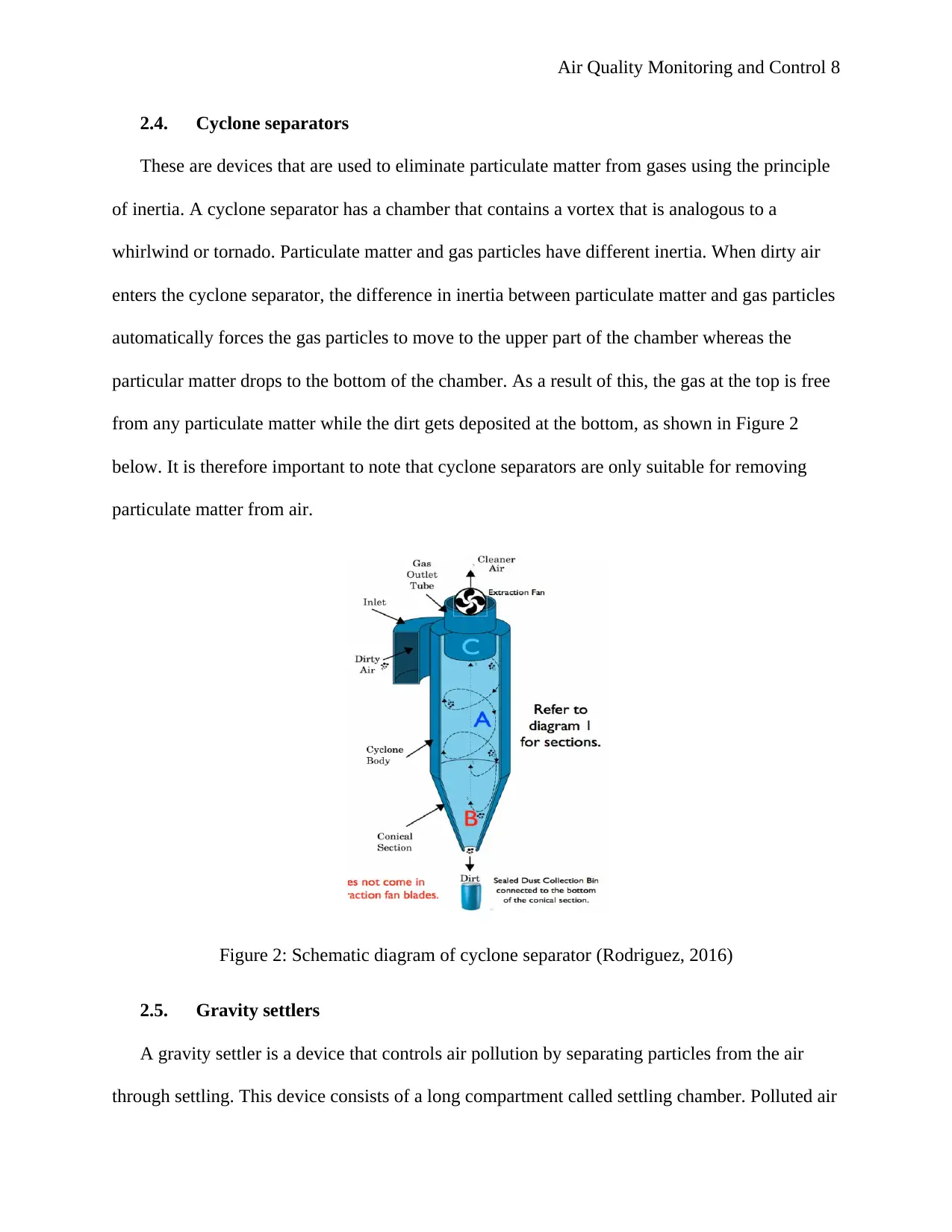
Air Quality Monitoring and Control 8
2.4. Cyclone separators
These are devices that are used to eliminate particulate matter from gases using the principle
of inertia. A cyclone separator has a chamber that contains a vortex that is analogous to a
whirlwind or tornado. Particulate matter and gas particles have different inertia. When dirty air
enters the cyclone separator, the difference in inertia between particulate matter and gas particles
automatically forces the gas particles to move to the upper part of the chamber whereas the
particular matter drops to the bottom of the chamber. As a result of this, the gas at the top is free
from any particulate matter while the dirt gets deposited at the bottom, as shown in Figure 2
below. It is therefore important to note that cyclone separators are only suitable for removing
particulate matter from air.
Figure 2: Schematic diagram of cyclone separator (Rodriguez, 2016)
2.5. Gravity settlers
A gravity settler is a device that controls air pollution by separating particles from the air
through settling. This device consists of a long compartment called settling chamber. Polluted air
2.4. Cyclone separators
These are devices that are used to eliminate particulate matter from gases using the principle
of inertia. A cyclone separator has a chamber that contains a vortex that is analogous to a
whirlwind or tornado. Particulate matter and gas particles have different inertia. When dirty air
enters the cyclone separator, the difference in inertia between particulate matter and gas particles
automatically forces the gas particles to move to the upper part of the chamber whereas the
particular matter drops to the bottom of the chamber. As a result of this, the gas at the top is free
from any particulate matter while the dirt gets deposited at the bottom, as shown in Figure 2
below. It is therefore important to note that cyclone separators are only suitable for removing
particulate matter from air.
Figure 2: Schematic diagram of cyclone separator (Rodriguez, 2016)
2.5. Gravity settlers
A gravity settler is a device that controls air pollution by separating particles from the air
through settling. This device consists of a long compartment called settling chamber. Polluted air
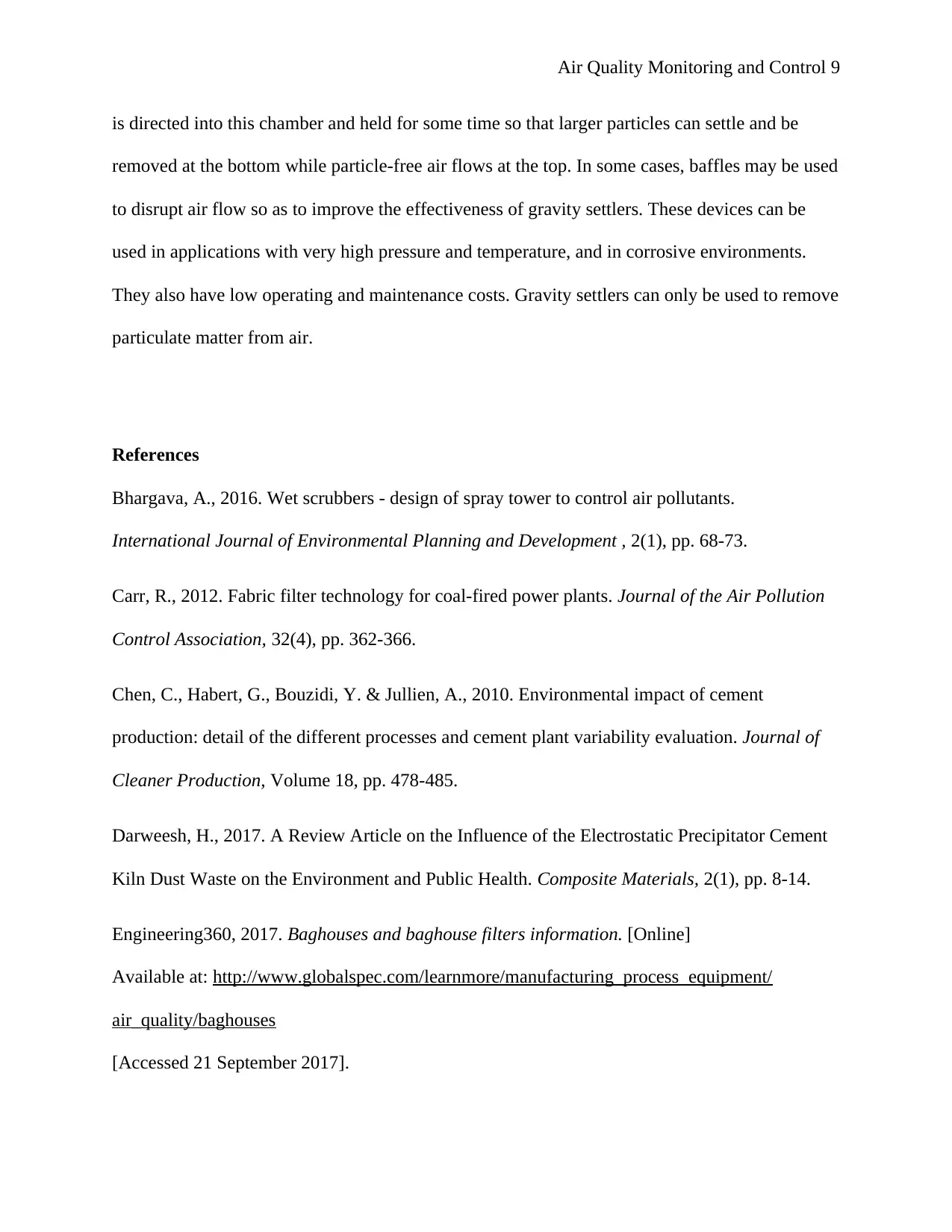
Air Quality Monitoring and Control 9
is directed into this chamber and held for some time so that larger particles can settle and be
removed at the bottom while particle-free air flows at the top. In some cases, baffles may be used
to disrupt air flow so as to improve the effectiveness of gravity settlers. These devices can be
used in applications with very high pressure and temperature, and in corrosive environments.
They also have low operating and maintenance costs. Gravity settlers can only be used to remove
particulate matter from air.
References
Bhargava, A., 2016. Wet scrubbers - design of spray tower to control air pollutants.
International Journal of Environmental Planning and Development , 2(1), pp. 68-73.
Carr, R., 2012. Fabric filter technology for coal-fired power plants. Journal of the Air Pollution
Control Association, 32(4), pp. 362-366.
Chen, C., Habert, G., Bouzidi, Y. & Jullien, A., 2010. Environmental impact of cement
production: detail of the different processes and cement plant variability evaluation. Journal of
Cleaner Production, Volume 18, pp. 478-485.
Darweesh, H., 2017. A Review Article on the Influence of the Electrostatic Precipitator Cement
Kiln Dust Waste on the Environment and Public Health. Composite Materials, 2(1), pp. 8-14.
Engineering360, 2017. Baghouses and baghouse filters information. [Online]
Available at: http://www.globalspec.com/learnmore/manufacturing_process_equipment/
air_quality/baghouses
[Accessed 21 September 2017].
is directed into this chamber and held for some time so that larger particles can settle and be
removed at the bottom while particle-free air flows at the top. In some cases, baffles may be used
to disrupt air flow so as to improve the effectiveness of gravity settlers. These devices can be
used in applications with very high pressure and temperature, and in corrosive environments.
They also have low operating and maintenance costs. Gravity settlers can only be used to remove
particulate matter from air.
References
Bhargava, A., 2016. Wet scrubbers - design of spray tower to control air pollutants.
International Journal of Environmental Planning and Development , 2(1), pp. 68-73.
Carr, R., 2012. Fabric filter technology for coal-fired power plants. Journal of the Air Pollution
Control Association, 32(4), pp. 362-366.
Chen, C., Habert, G., Bouzidi, Y. & Jullien, A., 2010. Environmental impact of cement
production: detail of the different processes and cement plant variability evaluation. Journal of
Cleaner Production, Volume 18, pp. 478-485.
Darweesh, H., 2017. A Review Article on the Influence of the Electrostatic Precipitator Cement
Kiln Dust Waste on the Environment and Public Health. Composite Materials, 2(1), pp. 8-14.
Engineering360, 2017. Baghouses and baghouse filters information. [Online]
Available at: http://www.globalspec.com/learnmore/manufacturing_process_equipment/
air_quality/baghouses
[Accessed 21 September 2017].
⊘ This is a preview!⊘
Do you want full access?
Subscribe today to unlock all pages.

Trusted by 1+ million students worldwide
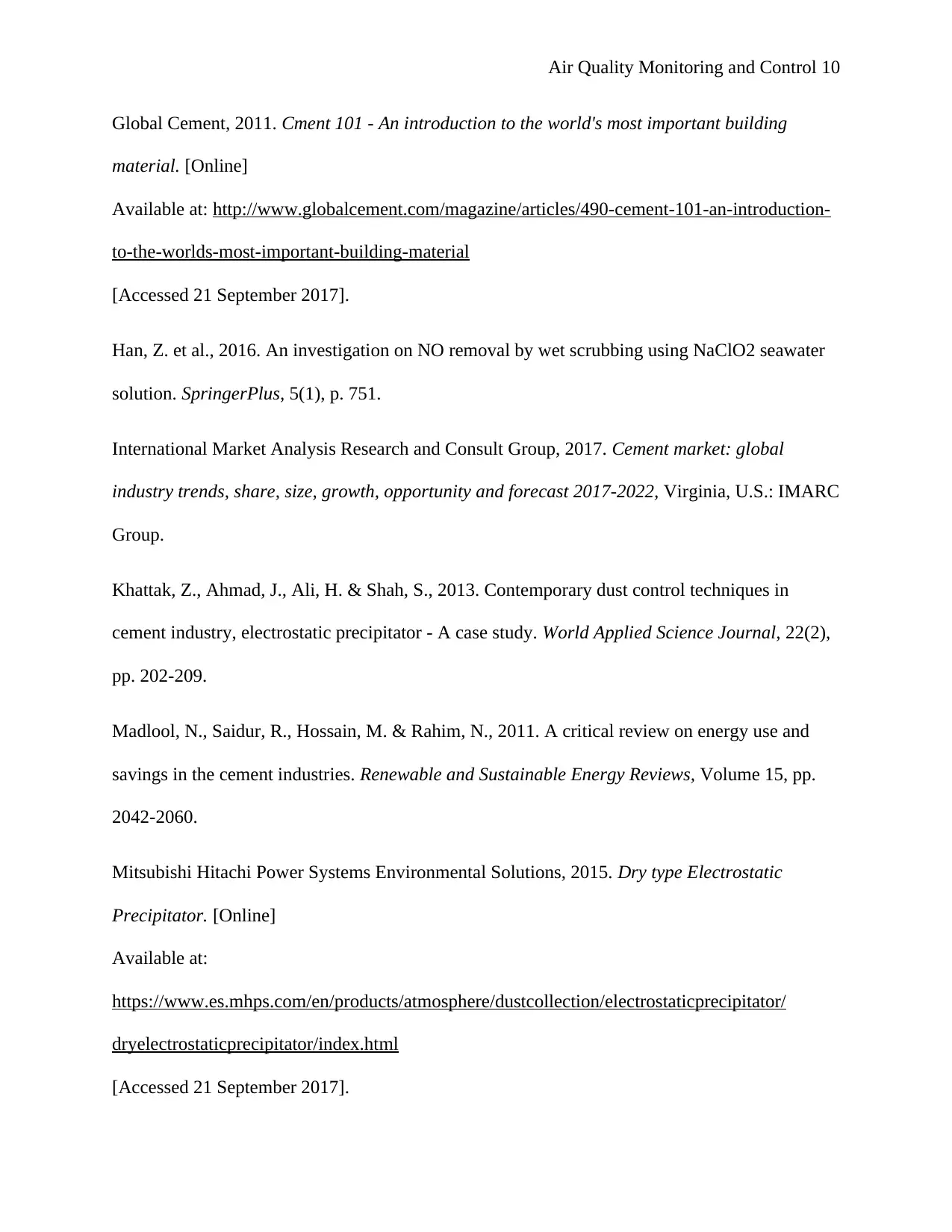
Air Quality Monitoring and Control 10
Global Cement, 2011. Cment 101 - An introduction to the world's most important building
material. [Online]
Available at: http://www.globalcement.com/magazine/articles/490-cement-101-an-introduction-
to-the-worlds-most-important-building-material
[Accessed 21 September 2017].
Han, Z. et al., 2016. An investigation on NO removal by wet scrubbing using NaClO2 seawater
solution. SpringerPlus, 5(1), p. 751.
International Market Analysis Research and Consult Group, 2017. Cement market: global
industry trends, share, size, growth, opportunity and forecast 2017-2022, Virginia, U.S.: IMARC
Group.
Khattak, Z., Ahmad, J., Ali, H. & Shah, S., 2013. Contemporary dust control techniques in
cement industry, electrostatic precipitator - A case study. World Applied Science Journal, 22(2),
pp. 202-209.
Madlool, N., Saidur, R., Hossain, M. & Rahim, N., 2011. A critical review on energy use and
savings in the cement industries. Renewable and Sustainable Energy Reviews, Volume 15, pp.
2042-2060.
Mitsubishi Hitachi Power Systems Environmental Solutions, 2015. Dry type Electrostatic
Precipitator. [Online]
Available at:
https://www.es.mhps.com/en/products/atmosphere/dustcollection/electrostaticprecipitator/
dryelectrostaticprecipitator/index.html
[Accessed 21 September 2017].
Global Cement, 2011. Cment 101 - An introduction to the world's most important building
material. [Online]
Available at: http://www.globalcement.com/magazine/articles/490-cement-101-an-introduction-
to-the-worlds-most-important-building-material
[Accessed 21 September 2017].
Han, Z. et al., 2016. An investigation on NO removal by wet scrubbing using NaClO2 seawater
solution. SpringerPlus, 5(1), p. 751.
International Market Analysis Research and Consult Group, 2017. Cement market: global
industry trends, share, size, growth, opportunity and forecast 2017-2022, Virginia, U.S.: IMARC
Group.
Khattak, Z., Ahmad, J., Ali, H. & Shah, S., 2013. Contemporary dust control techniques in
cement industry, electrostatic precipitator - A case study. World Applied Science Journal, 22(2),
pp. 202-209.
Madlool, N., Saidur, R., Hossain, M. & Rahim, N., 2011. A critical review on energy use and
savings in the cement industries. Renewable and Sustainable Energy Reviews, Volume 15, pp.
2042-2060.
Mitsubishi Hitachi Power Systems Environmental Solutions, 2015. Dry type Electrostatic
Precipitator. [Online]
Available at:
https://www.es.mhps.com/en/products/atmosphere/dustcollection/electrostaticprecipitator/
dryelectrostaticprecipitator/index.html
[Accessed 21 September 2017].
Paraphrase This Document
Need a fresh take? Get an instant paraphrase of this document with our AI Paraphraser
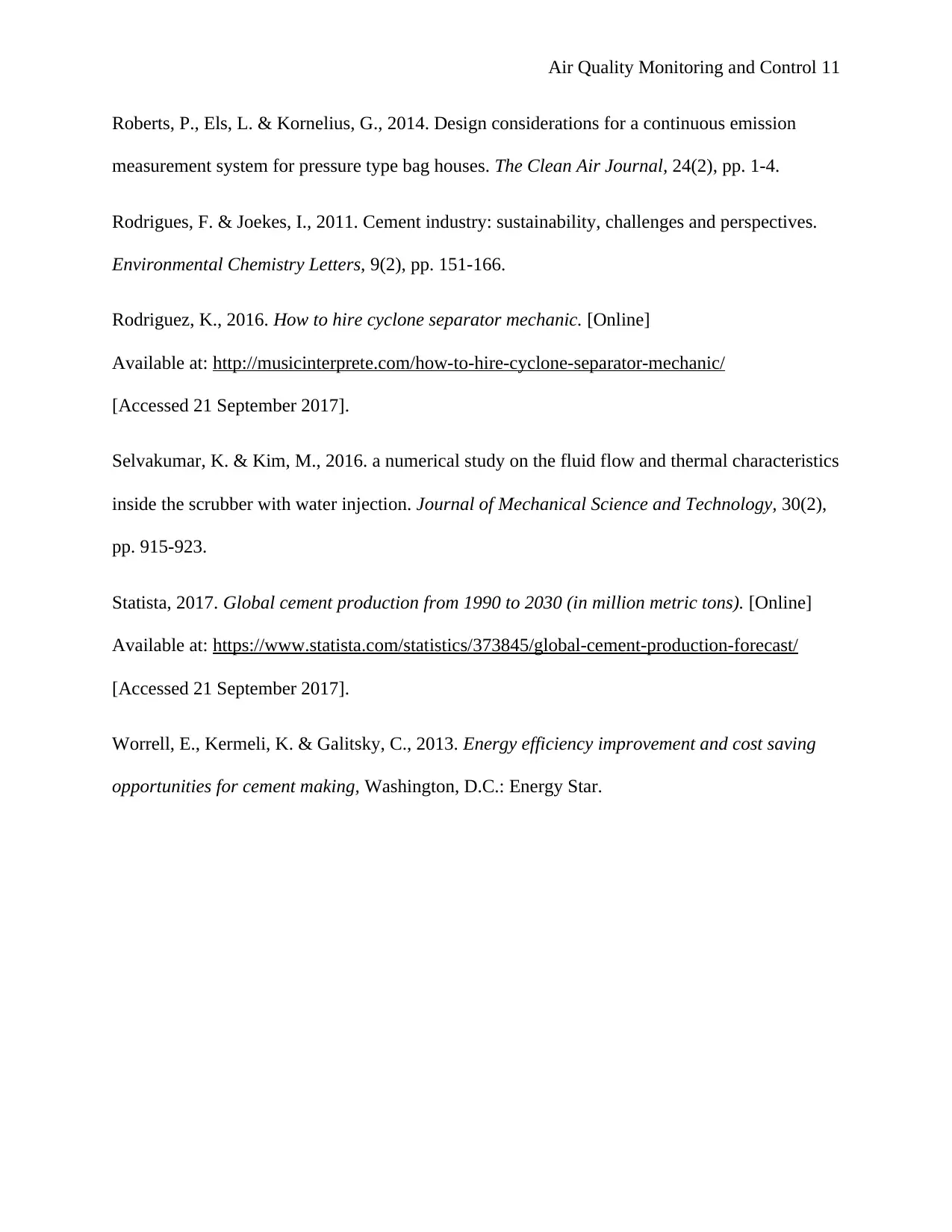
Air Quality Monitoring and Control 11
Roberts, P., Els, L. & Kornelius, G., 2014. Design considerations for a continuous emission
measurement system for pressure type bag houses. The Clean Air Journal, 24(2), pp. 1-4.
Rodrigues, F. & Joekes, I., 2011. Cement industry: sustainability, challenges and perspectives.
Environmental Chemistry Letters, 9(2), pp. 151-166.
Rodriguez, K., 2016. How to hire cyclone separator mechanic. [Online]
Available at: http://musicinterprete.com/how-to-hire-cyclone-separator-mechanic/
[Accessed 21 September 2017].
Selvakumar, K. & Kim, M., 2016. a numerical study on the fluid flow and thermal characteristics
inside the scrubber with water injection. Journal of Mechanical Science and Technology, 30(2),
pp. 915-923.
Statista, 2017. Global cement production from 1990 to 2030 (in million metric tons). [Online]
Available at: https://www.statista.com/statistics/373845/global-cement-production-forecast/
[Accessed 21 September 2017].
Worrell, E., Kermeli, K. & Galitsky, C., 2013. Energy efficiency improvement and cost saving
opportunities for cement making, Washington, D.C.: Energy Star.
Roberts, P., Els, L. & Kornelius, G., 2014. Design considerations for a continuous emission
measurement system for pressure type bag houses. The Clean Air Journal, 24(2), pp. 1-4.
Rodrigues, F. & Joekes, I., 2011. Cement industry: sustainability, challenges and perspectives.
Environmental Chemistry Letters, 9(2), pp. 151-166.
Rodriguez, K., 2016. How to hire cyclone separator mechanic. [Online]
Available at: http://musicinterprete.com/how-to-hire-cyclone-separator-mechanic/
[Accessed 21 September 2017].
Selvakumar, K. & Kim, M., 2016. a numerical study on the fluid flow and thermal characteristics
inside the scrubber with water injection. Journal of Mechanical Science and Technology, 30(2),
pp. 915-923.
Statista, 2017. Global cement production from 1990 to 2030 (in million metric tons). [Online]
Available at: https://www.statista.com/statistics/373845/global-cement-production-forecast/
[Accessed 21 September 2017].
Worrell, E., Kermeli, K. & Galitsky, C., 2013. Energy efficiency improvement and cost saving
opportunities for cement making, Washington, D.C.: Energy Star.
1 out of 11
Related Documents
Your All-in-One AI-Powered Toolkit for Academic Success.
+13062052269
info@desklib.com
Available 24*7 on WhatsApp / Email
![[object Object]](/_next/static/media/star-bottom.7253800d.svg)
Unlock your academic potential
Copyright © 2020–2025 A2Z Services. All Rights Reserved. Developed and managed by ZUCOL.





